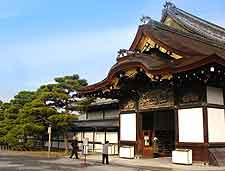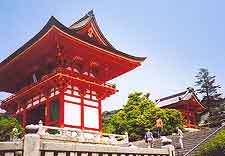Kyoto History Facts and Timeline
(Kyoto, Kansai, Central Honshu, Japan)

One of Japan's true gems, Kyoto has a known history that dates back to roughly the 6th century. This is about the same time that the Shimogamo Shrine (Shimogamo-jinja) is thought to have been constructed, and this ancient landmark is still standing within the Sakyo ward of today.
Kyoto, under various different names including Heian-kyo, was the capital of Japan from 794 AD until 1869, when Tokyo was awarded that accolade after the Imperial Restoration (Meiji Restoration) arrived in Japan, the year before.
The Onin War and the Recovery
When the Onin War came along in 1467, Kyoto saw much of its infrastructure damaged and destroyed, with this war lasting for an entire decade. It was not until the middle of the 16th century that it was anywhere near fully recovered. The war witnessed much fighting between samurai factions, while religious factions and the court nobility also suffered at this time.
The wealthiest residents transformed their grand homes into make-shift fortresses, the city's defence was bolstered by digging deep trenches, and many buildings were set alight. Such destruction and devastation has thankfully not been seen since.
The 16th century saw things change for the better, with the city becoming more structured and organised at the hands of influential general and politician, Toyotomi Hideyoshi (in office between 1585 and 1591). He built extensive walls around the city, referred to as 'Odoi', and erected and relocated temples in what is now named the Buddhist temple quarter, located on Teramachi Street, close to Shijo Street. During this time, known as the Edo period, Kyoto's economy grew and the city soon ranked amongst Japan's top three most important cities.

Further Destruction and Hard Times
More destruction occurred during the Hamaguri rebellion when, in the year of 1864, almost 30,000 of the city's houses were burnt to the ground. These were tough times in the history of Kyoto, with the Emperor's decision to reside in
Tokyo just five years later having a very negative effect on the overall economy.
Following two decades in the doldrums, the modern day city was formed in 1889. A year later, the Lake Biwa Canal (Biwako Sosui) came into being as one of the key plans to restore the fortunes of the ailing city. The measures were successful as people flocked to Kyoto, with the population subsequently surpassing one million in the early part of the 1930s.
Third-Time Lucky
After being obliterated twice already in its history, Kyoto was spared a third time when the United States opted against dropping an atomic bomb here in 1945, just before World War II finished. The decision was taken because Kyoto was viewed as one of Japan's more intellectual cities and, therefore, was home to a population who would fully comprehend the weapon's significance. As a result, the city was taken off the target list and replaced by
Nagasaki. During the war, other than relatively minor air raids, this city was spared the damage that many other Japanese locations suffered.
Post-War Years
Since Kyoto did not suffer significant war damage, it means that it is now one of the few cities in Japan to still boast a sizeable selection of ancient buildings. As a result, the city attracts a large number of tourists, coming to see such attractions as the wooden 'machiya' Japanese townhouses, as well as the many shrines, temples and castles.
In 1956, Kyoto finally achieved city status, while more recently, in 1997, it successfully staged the conference that resulted in the Kyoto Protocol, which aims to fight global warming by various means.
 One of Japan's true gems, Kyoto has a known history that dates back to roughly the 6th century. This is about the same time that the Shimogamo Shrine (Shimogamo-jinja) is thought to have been constructed, and this ancient landmark is still standing within the Sakyo ward of today.
One of Japan's true gems, Kyoto has a known history that dates back to roughly the 6th century. This is about the same time that the Shimogamo Shrine (Shimogamo-jinja) is thought to have been constructed, and this ancient landmark is still standing within the Sakyo ward of today.